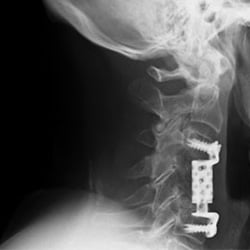About X-ray examinations
The conventional X-ray examination was the first medical imaging procedure in history. Its technology is based on X-radiation. X-raying has been a basic diagnostic procedure to the present day. The possibilities and technical preconditions have improved significantly within the last 100 years, which is why an optimal X-ray image with a low radiation exposure is possible today. Digital luminescence radiography is used at Beta Klinik, which means that images can be digitized and do not have to but can be printed.
X-rays penetrate the body and react with a medium behind it during an X-ray examination. Film is the medium of conventional X-raying. A digital receiver creating digital data sets substitutes film in case of digital X-raying.
The image on the left is detail of an x-ray image created after cervical spine surgery. Postsurgically, it was crucial to assess the adequate position of the vertebral body replacement.



